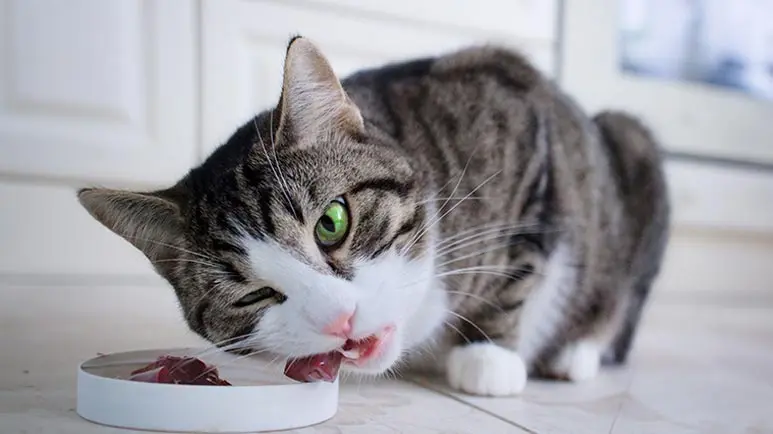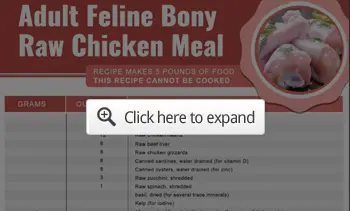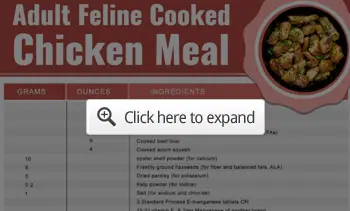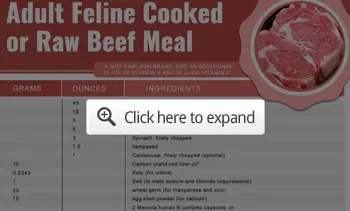This Pet Feeding Mistake Can Lead to Obesity and Diabetes
Nutrition experts now agree, it's a bad idea to feed this to your pet. Some pets lack the salivary, intestinal and pancreatic enzyme activity to digest this food, so feeding it may be asking for trouble. Here's what I recommend instead.

STORY AT-A-GLANCE
- Cats are obligate carnivores and need to be fed like carnivores to be optimally healthy
- Feline nutrition experts agree: Feeding kibble to kitties is a bad idea
- Carbohydrate-dense diets contribute to feline obesity and diabetes epidemics and can cause a host of other health problems as well
- Cats have unique dietary needs that are best met by a moisture-rich, meat-based diet
- Making small batches of fresh, real food in your own kitchen, with ingredients you select, is the best way to ensure you’re feeding a nutritionally balanced, species-appropriate, optimally nutritious diet to your cat
Editor's Note: This article is a reprint. It was originally published August 21, 2018.
To my complete delight, I recently saw a headline in a Texas newspaper that reemphasized that cats are carnivores and should eat like them. It's rare to see a mainstream media news article about feline nutrition, and rarer still to see one that isn't pushing something trendy and ill-advised, such as vegetarian diets for cats.
The article, which appeared in The Eagle, points out that cats are obligate carnivores, meaning they must have meat in their diet and need few carbohydrates.
"An obligate carnivore (or true carnivore) is an animal that must eat meat in order to thrive (Syufy 2008). They may eat other foods, such as fruits, honey, grains, and so forth, but meat must be included in their diet.
True carnivores lack the physiology required for the efficient digestion of vegetable matter, and, in fact, some carnivorous mammals eat vegetation specifically as an emetic. The domestic cat is a prime example of an obligate carnivore, as are all of the other felids (Pierson 2008)."1
Cats in the wild live by their natural instincts, and are therefore the "leading experts" on the best diets for kitties. As we know, free-roaming cats consume small prey animals, typically mice and birds. Since the kitties in our homes don't get the opportunity to hunt, it's important for cat parents to mimic the high-protein, low-carb feline ancestral diet.
The Case Against Kibble for Cats
The expert who contributed to the article in The Eagle is veterinarian Dr. Deb Zoran of Texas A&M College of Veterinary Medicine & Biomedical Sciences. Zoran also happens to be the author of one of the most-cited, wonderful research papers in existence on cat nutrition, "The carnivore connection to nutrition in cats", published in 2002, which another feline nutrition expert, Dr. Lisa Pierson, is kind enough to host on her site, CatInfo.org.
Zoran believes the best way to mimic the natural diet of cats is to feed canned food with a protein content of 40% or higher, and a carb content of 10% or lower. My opinion is that while this is probably the most convenient approach, and is certainly preferable to feeding kibble, there's an even better way to feed your cat, which I'll discuss shortly. There are many problems with dry cat food, including lack of moisture.
"Cats are used to getting a large percentage of their daily water needs from their diet," Zoran told The Eagle, adding that a dry food diet makes it harder for kitties to stay hydrated. "All dry foods are low moisture, so cats that eat only dry foods consume less water and are more prone to dehydration."2
Zoran makes the point that kibble can cause health problems in cats, including obesity and diabetes, because dry food is typically high in fat, carbs and calories. It can also cause digestive issues simply because the feline stomach isn't designed to digest and absorb carbohydrates.
Why Feeding Carbs to Your Cat Is Asking for Trouble
Kitties lack the salivary, intestinal and pancreatic enzyme activity necessary to thoroughly break down and digest carbs. They evolved to eat very low amounts of grains and starches, so a diet high in carbohydrates can and often does create ill health, especially when it comes to feline obesity and diabetes.
The activity of your cat's liver enzymes is designed to use protein and fat — not starch — as a source of energy. The majority of carbs in a cat's diet are ultimately stored as fat. Cats were designed to consume less than 19% carbs in their diet; higher levels require the pancreas to produce more insulin and more digestive enzymes to break them down.
That's why many cats end up with chronic pancreatitis, inflammatory bowel disease (IBD) and diabetes — these terrible diseases are a result of chronic dietary abuse.
And don't go looking for carbohydrate content on your bag of cat food because manufacturers don't want you to know. Instead, do a simple calculation to find out how much sugar (in the form of carbs) you're actually feeding. Add up the amount of protein, fat, moisture and ash (estimate 6% if it's not listed), and subtract the total from 100. That number is the percentage of carbs (sugar) found in your kitty's food.
It's easy to see why so many cats have chronic inflammatory and degenerative diseases — they're being fed a very unnatural diet of refined carbs they were never meant to eat.
The livers of cats also do not produce the enzyme necessary to metabolize simple sugars. Research shows that cats fed diets high in simple sugars become hyperglycemic. Most cats aren't attracted to sweet-tasting foods (unlike dogs and people), and instead prefer food that tastes like animal products. This is one of several clear indicators of the strict carnivorous nature of felines.
Unprocessed Animal Tissue Meets All of Your Cat's Unique Nutritional Requirements
Felines have a unique nutritional biochemistry that is significantly different from other animals. As obligate carnivores, they must consume nutrients in animal tissue to meet their very specific nutritional requirements.
When it comes to protein, kittens require 1.5 times the amount as the young of other species. Adult cats need two to three times the amount of protein other adult animals require. This is because omnivores and other mammals use most of the protein they consume not as a source of energy, but for growth and body maintenance. Cats use protein for those purposes, and also as a source of energy.
When most animals are fed a low-protein diet, their bodies make adjustments to conserve amino acids to manage the deficit. But a cat's body must continue to use protein even when there's not enough in the diet, which is why protein malnutrition happens quickly in sick or injured cats, and kitties suffering from anorexia.
In addition to their increased need for protein, cats have a higher requirement for certain specific amino acids, such as taurine, found naturally in animal tissue.
They also have a special requirement for vitamin A, which is available naturally only in animal tissue. They lack the intestinal enzymes necessary to convert B-carotene in plants to the active form of vitamin A. Vitamin A is essential for maintenance of vision, growth of bone and muscle, reproduction, and the health of epithelial tissues.
Vitamin D is also essential in the diets of cats because they lack the ability to synthesize it through their skin. The liver and fatty tissue of free-range animals is rich in vitamin D.
Domestic cats evolved from desert-dwelling ancestors, which is why they must get most of their water from the food they eat. Felines are not as responsive as other animals to sensations of thirst or dehydration. When fed a dry food diet, cats aren't driven to search for another source of water to make up the difference between what their bodies require and what their diet provides.
This results in chronic mild dehydration, a condition that will ultimately result in disease, especially of the feline lower urinary tract and kidneys.
Cats Are Carnivores, so Feed Them Like Carnivores!
Nutritionally balanced, raw homemade food is the best diet you can feed your kitty. However, it's very important not to wing it when preparing your pet's meals at home. It's critically important that you know your homemade diet is balanced.
One of the best things about a well-designed, homemade raw diet is you get to handpick the ingredients. Making your own cat food can provide peace of mind because it's becoming increasingly difficult to find ethical pet food companies that use locally sourced or even U.S.-grown ingredients.
With homemade food (fed raw, warmed or gently cooked), you're in complete control of every ingredient that enters your cat's body. Fresh, unadulterated food contains all the enzymes and phytonutrients that are typically destroyed during intense food processing that is designed to create processed cat foods that are shelf-stable for months to years.
Making small, fresh batches of real food is the best way to ensure you're delivering the maximum level of species appropriate nutrition to your kitty. Here are a few homemade recipes to try:














